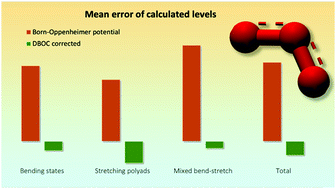Diagonal Born–Oppenheimer corrections to the ground electronic state potential energy surfaces of ozone: improvement of ab initio vibrational band centers for the 16O3, 17O3 and 18O3 isotopologues†
Abstract
Mass-dependent diagonal Born–Oppenheimer corrections (DBOCs) to the ab initio electronic ground state potential energy surface for the main 16O3 isotopologue and for homogeneous isotopic substitutions 17O3 and 18O3 of the ozone molecule are reported for the first time. The system being of strongly multiconfigurational character, multireference configuration interaction wave function ansatz with different complete active spaces was used. The reliable DBOC calculations with the targeted accuracy were possible to carry out up to about half of the dissociation threshold D0. The comparison with the experimental band centers shows a significant improvement of the accuracy with respect to the best Born–Oppenheimer (BO) ab initio calculations reducing the total root-mean-squares (calculated–observed) deviations by about a factor of two. For the set of 16O3 vibrations up to five bending and four stretching quanta, the mean (calculated–observed) deviations drop down from 0.7 cm−1 (BO) to about 0.1 cm−1, with the most pronounced improvement seen for bending states and for mixed bending-stretching polyads. In the case of bending band centers directly observed under high spectral resolutions, the errors are reduced by more than an order of magnitude down to 0.02 cm−1 from the observed levels, approaching nearly experimental accuracy. A similar improvement for heavy isotopologues shows that the reported DBOC corrections almost remove the systematic BO errors in vibrational levels below D0/2, though the scatter increases towards higher energies. The possible reasons for this finding, as well as remaining issues are discussed in detail. The reported results provide an encouraging accuracy validation for the multireference methods of the ab initio theory. New sets of ab initio vibrational states can be used for improving effective spectroscopic models for analyses of the observed high-resolution spectra, particularly in the cases of accidental resonances with “dark” states requiring accurate theoretical predictions.

- This article is part of the themed collection: 2020 PCCP HOT Articles


 Please wait while we load your content...
Please wait while we load your content...